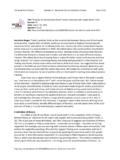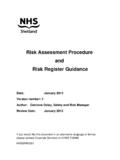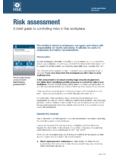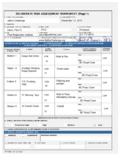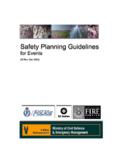Transcription of RISK ASSESSMENT, VIOLENT CLIENTS AND …
1 RISK assessment , VIOLENT CLIENTS AND PRACTITIONER safety Workshop Handout Prepared by: Christina E. Newhill, , LCSW School of Social Work University of Pittsburgh Christina Newhill, 412. 1 Topics to be considered: How and why client violence is a critical issue for social workers and other human services professionals Identification of key risk markers for VIOLENT behavior within three spheres: How to prepare oneself to ensure safety in both office and field settings Reasons we choose social service work: To help individuals, families and communities achieve quality of life, To help foster social justice, To advocate on behalf of those who are oppressed, vulnerable and at risk To help make the world a better place What causes social service workers to be targets for a client's VIOLENT behavior?
2 Such violence represents a barometer for our VIOLENT society Long standing social problems can create an environment in which violence can thrive Our roles as social workers: Balancing Care versus Control Political issues and policy shifts: Number of people needing public assistance and other social services has increased Budget cuts Understaffing in agencies Rising caseloads CLIENTS are desperate, frightened, hopeless and angry Public anger at social services Because of confidentiality, social service workers are often unable to explain or defend their actions publicly The public often does not understand our work What can be done to prevent such incidents from occurring, and still provide CLIENTS with the best services?
3 Christina Newhill, 412. 2 Statistics from Client Violence Toward Social Workers Study (Newhill, 2003) Types of Incidents of Client Violence Reported by All Respondents in Sample (N=1129) Type of Incident Percent of Sample No incidents reported 42% Incidents of VIOLENT reported 58% Property damage 25% Threats 50% Physical attacks 24% Incidence of Violence by Primary Area of Practice (N=1129) Primary Area of Practice % Reporting No Incidents % Reporting Incidents High Risk Criminal justice 21% 79% Drug and alcohol services 24% 76% Children and youth/child welfare 25% 75% Moderate Risk Mental health services 36% 64% Developmental disabilities/ MR
4 44% 56% School social work 46% 54% Family services 46% 54% Lower Risk Medical/health care 51% 49% Services to the aged 56% 44% Type of Violence by Gender for Total Sample Type of Incident Male SWers (N=221) Female SWers (N=869) No incidents 27% 48% Property damage 42% 21% Threats 64% 47% Physical attacks 39% 21% Christina Newhill, 412.
5 3 Average Number of Incidents by Gender and Type of Violence Type of Incident Male SWers Female SWers Property damage 9 7 Threats 12 6 Attempted physical attacks 12 4 Actual physical attacks 9 2 Feelings Immediately Following the Incident of Client Violence Emotional feeling Property damage Threats Physical attacks Angry 55% 45% 38% Scared / fearful 36% 65% 42% Anxious 43% 61% 23% Guilty 10% 7%
6 5% Sad 21% 11% 7% Embarrassed / humiliated 9% 11% 7% Irritated / annoyed 3% 1% 5% Shocked / shook-up 2% 2% 36% Helpless / inadequate 2% 7% 18% Drained / exhausted 2% 1% 14% Conclusions from findings presented: Client violence is not a rare event; Risk varies according to where one works; Male social workers are at a significantly greater risk of experiencing client violence than females; Experiencing an incident of client violence exacts an emotional toll on the social worker involved.
7 Individual/Clinical Risk Markers: Demographic risk markers $ Young age $ Male gender (although not always) Clinical risk markers: $ High risk psychiatric symptoms (delusions, hallucinations, and VIOLENT fantasies) $ Personality features (anger, emotional dysregulation, impulsivity) $ Personality disorder (antisocial, borderline) $ Substance abuse (particularly alcohol) Christina Newhill, 412. 4 Biological risk markers: $ Low intelligence quotient (IQ) $ Neurological impairment Historical Risk Markers: $ History of violence (recency and frequency of self reports of violence toward others, arrests, incarcerations, and reports of violence toward self) $ Social and family history (early exposure to violence) $ Work history (economic instability, unemployment) $ History of psychiatric treatment and hospitalization Environmental/Contextual Risk Markers.
8 $ Level and quality of social support $ Peer pressure from peers who endorse violence $ Influence of popular culture $ Means for violence (access to lethal weapons and knowledge of how to use them) $ Potential victims that are accessible Summary of Guidelines for Risk assessment of the VIOLENT Client Background/Collateral Information $ Review available official documents: clinical records including past hospitalizations, medication orders, other treatment; criminal justice records, arrests and incarcerations; $ Determine whether there is any past history of violence toward self or others or any history of abuse either as perpetrator or victim. If there is a history, determine triggers, targets and circumstances.
9 Clinical assessment of the Client $ Note anything significant about the client's physical appearance suggestive of risk for violence including scars, tattoos or certain dress patterns; $ Note if the client is angry, hostile, agitated, threatening or verbally abusive; $ Note the extent to which the client is compliant with routine requests and procedures as an indicator of the client=s ability to control their behavior. $ Conduct a diagnostic assessment to determine the presence of any psychiatric or medical risk markers including whether there is evidence of substance abuse; $ Inquire about the client=s potential for violence toward others including who, why, how and when they may harm another individual; Christina Newhill, 412.
10 5$ Inquire about the client=s potential for violence toward self; $ Following your evaluation, obtain consultation from colleagues and provide written documentation that sufficient risk assessment information has been obtained and evaluated, and that the decision as to whether the client poses a potential for violence has been based on that information and a follow-up plan for re-evaluation of violence potential has been implemented. Environmental assessment for Social Worker safety $ When making a home or field visit, you are not on your own turf; $ Whereas the social worker may view the home visit as an explicit demonstration of a desire to help, the client may perceive it as threatening; $ Do not allow the desire to help override prudent caution $ Get to know and evaluate the neighborhood ahead of time via observation, consultation with colleagues, consultation with local police; $ Make sure your car is in good working order, know how to access emergency help, lock your car at all times.
